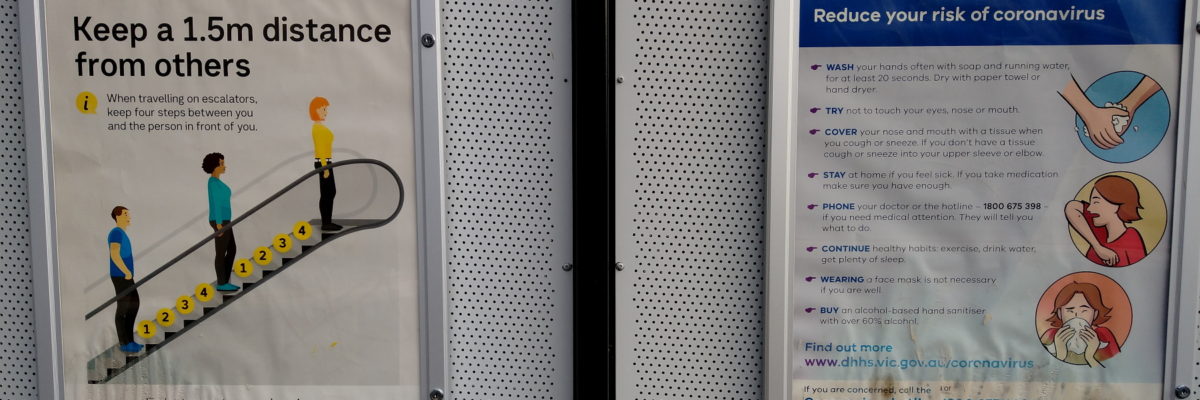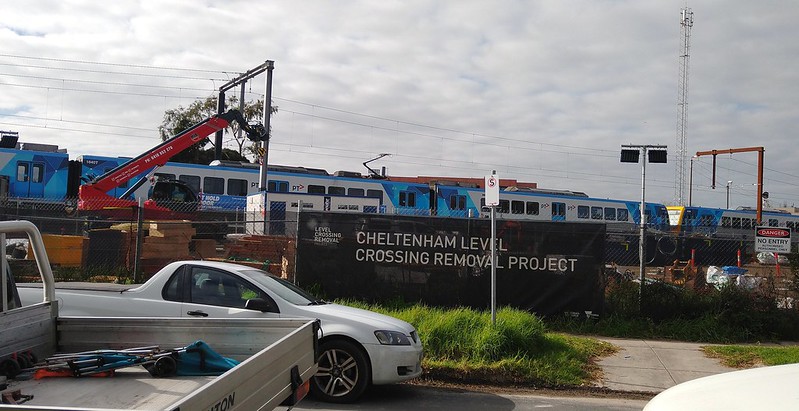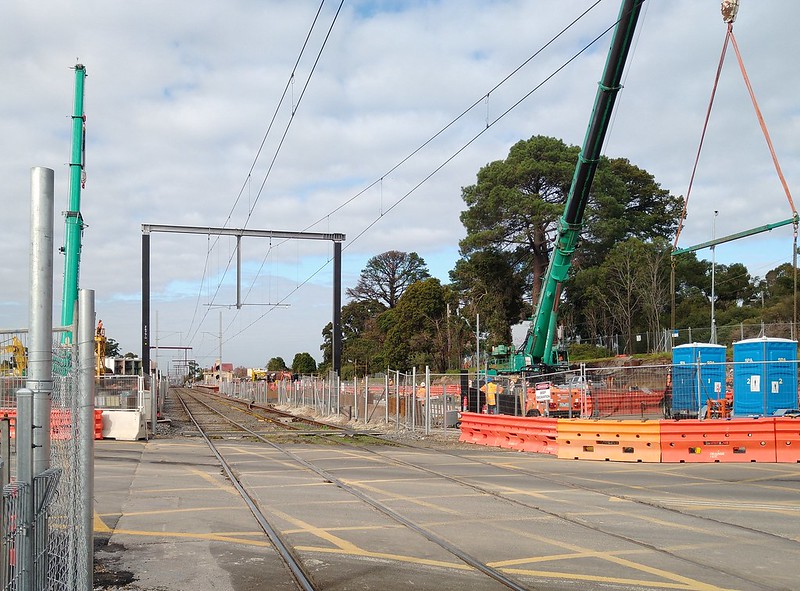The other day I caught a train for the first time in weeks.
COVID-19 has meant that most of my travel has been on foot around my neighbourhood. I’m working from home, and I’m lucky enough that most of my daily needs are well within walking distance.
But on Thursday I ventured back onto public transport, small bottle of hand sanitiser at the ready, to run an errand in Cheltenham.
My Yearly Myki Pass is frozen, and rather than start the clock ticking again, I used Mobile Myki.
For my little jaunt it was Comeng trains both ways, so I had to open the doors by hand. Metro at one stage was investigating whether the X’trapolis and Siemens trains could be set to have doors open automatically – not sure what happened with this.
Cheltenham and Mentone stations are both closed (from March until August) due to level crossing works to remove three crossings. Instead of waiting for the replacement bus, I walked from Southland to Cheltenham, which took about 15 minutes, and gave me an opportunity to look at some of the works.
The big shutdown for these works starts at the end of this week: 23rd May to 26th July between Moorabbin and Mordialloc.
And the journey itself?
The stations were quiet, as were the trains. It wasn’t peak hour, but there were perhaps 3-4 people in each carriage – plenty of space to stay spatially distant.
Can people stagger their trips?
I’m hearing public transport patronage has climbed slightly since a few weeks ago. Instead of being 90% below normal, it’s now “only” 85% below normal, with around 300,000 trips per weekday.
The RTBU has called for actions (Paywall) such as a safety campaign and hand sanitiser at stations, which makes sense, though limiting passenger numbers per service would be difficult.
The key as things ramp up is for authorities to ensure there’s enough capacity that vehicles aren’t crowded, including frequent services right through the day so people can stagger their trips, as noted in this Channel 9 story last night:
The big problem is that staggering trips is that it’s a hard ask on most of the rail lines with 20 minute off-peak services, with trains that normally can be just as busy as peak hour.
With schools starting to return next week, and the economy getting restarted in the coming weeks and months, it’s inevitable that we’ll see more people on public transport.
The government will have to do everything it can to ensure risks are minimised for both passengers and staff.
Update: the NSW Government has announced restrictions on bus, ferry and train capacity – though it’s unclear how the latter would be enforced.
Trains will run at 24 per cent capacity and buses at 14 per cent for the foreseeable future, meaning Sydneysiders may be prevented from entering stations as they fill up or watch near-empty buses drive past their stops.
SMH: Capacity slashed in Sydney coronavirus public transport overhaul




9 replies on “Getting back on PT”
This raises the fascinating question as to what public transport (and air travel) will look like when we get to the “other side”? Perhaps indeed the days of the “9 to 5” office job are over, and people will work from home to some extent, but there will inevitably be a drift back to working in the office or wherever for at least some of the time. As you say, staggered hours will help, but it’s hard to envisage a scenario where effective social distancing can be maintained on public transport on an on-going basis, vaccine or no vaccine.
If now isn’t the time to finally introduce 10-minute off-peak services on lines which can support it, I don’t know when is. Promote it far and wide too. I went about seven weeks without using a train until last week (for context, pre-covid I used trains fairly regularly and don’t drive).
Thanks Daniel. You pose many questions – the authorities have not provided any answers yet. The Premier keeps saying, if you can work from home, work from home.
I can’t see the authorities enforcing limits on trains. That would need 12 or 18 staff per platform for each train arrival. And how would they enforce social distancing at the poorly designed platforms of Parliament and Flagstaff which get completely cramped?
Not sure how avoiding peak would work – leave before 3:30 or after 6:30 when they run fewer services. I’m not looking forward to this.
Masks should be encouraged, particuarly for passengers who occasionally cough through asthma or have watery eyes through hay fever. It is common in east Asia such as Japan. The medical advice is “If you’re sick stay home”. Does that mean not venturing out for someone with occasional asthma?
A great long-term outcome of COVID 19 would be greater acceptance of masks on public transport. It would reduce the transmission of colds and flu.
It also raises another crucial question: What’s making the people who previously worked remotely return to the office? What’s stopping offices from asking them to keep working remotely? Should the State Governments keep recommending working from home where they can? Should only some staff return to the office (and even that being, say 2-3 days out of 5, or alternate between office/home weekly)?
Corporates are leading the way when it comes to work from home policies. The incentive is avoiding a total shut down of the office for several days should infection occur. Not to mention the media attention surrounding your business name as a cluster. My question to many people is how do you act when you visit the supermarket. Probably same length of time spent in there as a train. More people than a train. You touch more items than a train. They clean the trolleys and the baskets but they don’t clean every package on every shelf that “could” have been touched. I still visit the supermarket 2 or 3 times a week.
A reminder that the Hurstbridge line beyond Eltham has a 40 min frequency off peak and 60 mins after 7pm……
I really can’t see how it is going to work. The numbers normally using the Cranbourne/Pakenham line are certainly not conducive to physical/social distancing. Earlier this year, just before everything closed down, on my way home (catching the train at South Yarra) I counted that I was actually in physical contact with seven people. While this was more than usual, it’s very common to be in physical contact with 2-3 others. People who want to catch the train from middle or inner stations towards the CBD will never be able to get on if distancing is required.
I don’t think staggering work hours is going to help much either – some lines are busy all day. I think it can only work if the majority of people who can work at home continue to do so.
Luckily I’m commuting in the counterpeak direction to Geelong, where normally if someone sits next to you it’s busy! Definitely much quieter at the moment. I either take the 216 or 410 bus to Footscray or the train to Sunshine to connect – I was a bit concerned about the bus early on, but generally only 3-4 people on it (and I’m only on it for five minutes). However it wouldn’t take much for buses to struggle with physical distancing – I think the limit is probably something like 15. And I think I’ve even managed a private carriage on the Warrnambool train which runs express to Geelong! (And a private coach home one night before Easter when rail works were on – maybe I should’ve got the coach driver to actually drop me home rather than go all the way into Southern Cross!)